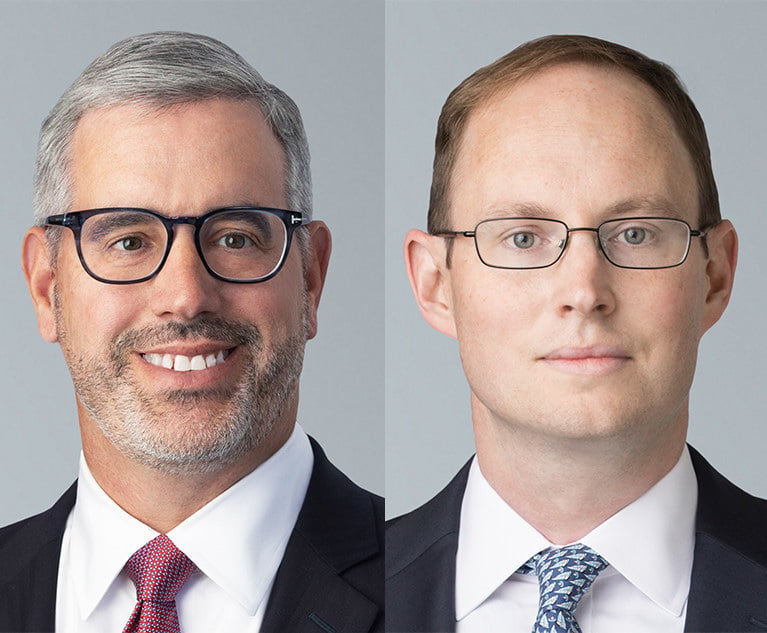Ron Younkins, Who Ran NY Courts for 2 Decades, Is Retiring
"He knows where all the bodies are buried and has a deep understanding of the internal politics of the court system, which is essential to getting things done.," Chief Administrative Judge Lawrence Marks said.
April 09, 2018 at 11:51 AM
5 minute read

If you don't know who Ron Younkins is, don't fret. Younkins admits his own daughter, who is a New York attorney, only has a vague idea of what he does.
But for those in the know, Ron Younkins is a BIG DEAL. He is the executive director of the Office of Court Administration responsible for a lot of what matters to NY lawyers: Administrative Services, Court Research, Facilities Management, Financial Management, Human Resources, Justice Court Support, Professional and Court Services, Public Affairs, Public Information, Public Safety, Technology and Workforce Diversity.
No wonder he's retiring after 22 years. He probably doesn't want to remember the names of all those departments anymore.
Seriously, the New York State court system—with its $3 billion budget—is a behemoth. Younkins oversees more than 300 courthouses, more than 15,000 employees and 1,300 state paid judges in 62 counties. And then there's the roughly 2,000 town and village judges who also receive state support.
“He's someone who made a truly invaluable contribution to the progress of court administration in this state for the last two decades,” said Chief Administrative Judge Lawrence Marks in an interview. “I think he's largely been under the radar of the broader justice and legal community. But he knows where all the bodies are buried and has a deep understanding of the internal politics of the court system, which is essential to getting things done.”
Younkins agrees that he has kept a low profile. He says his 31-year-old daughter is still trying to figure out his responsibilities.”She sends a $375 check every two years for attorney registration and so she knows we do that,” he says.
“I see my job as the person that is providing the resources, whether it's money, time of our tech people, resources for hiring people,” Younkins continues. “It's not really something the legal profession would focus on a lot because it's sort of behind the scenes.”
Under Younkins, there have been dramatic changes since 1996, and he has played major roles in all of them. Downsizing the workforce in bad times? Check. Rebuilding the workforce in flush times? Check. Instituting 4:30 p.m. court closings to save on overtime pay? Check. Going back to 5 p.m. closings to reduce case backlogs? Check. Renovating and building courthouses? Check. Making sure those who are not proficient in English have interpreters? Check. Providing computers to town and village courts? Check. E-filing? Check. And the list goes on.
Surprisingly, when you ask Younkins to cite his most important accomplishments, the first thing that comes to mind isn't the shiny new facilities or whiz-bang technology. He speaks instead about how he had to find a way to pay for $300 million in rising costs during the lean budget years that started in 2009 and ended in 2014.
“Since that time, the judiciary has received modest increases in its budget, but not enough to cover all of the increased costs that we faced, he says.
“Throughout this entire time period, the challenge has been to live within our budget and still give the courts the resources that they need. The goal was to find savings that had the least impact on service to the public,” he explains.
Another source of pride for Younkins is the state's support of the Justice Courts. First some background: When the state took over court operations in the 1970s, the Justice Courts, which handle more mundane but still important matters such as parking summonses and landlord-tenant disputes, remained the responsibility of towns and villages. And some of the nearly 1,300 Justice Courts in the state were functioning without computers and recording devices long after they were a mainstay in the state courts.
In 2006, Younkins and Marks developed an action plan to bring resources and technology to the Justice Courts that is still having an impact to this day. Just a few months ago, the state put a case management system into place, the latest of a series of innovations. There is also a $3.5 million state program for the Justice Courts, providing grants of up to $30,000 per court.
Altogether, the state's intervention in the Justice Courts “has had a major impact on improving those court operations,” Younkins said.
As far as upgrading court facilities, Younkins said the state has made a lot of headway during his tenure. That's particularly true in the Bronx, Queens, Brooklyn and Staten Island.
But improvements in Manhattan have lagged behind the other four boroughs, Younkins said. That's because of the sheer number of court buildings in Manhattan and the difficulty of making renovations in facilities that are in constant use. Of the slower progress in Manhattan, Younkins says, ”I think that would be one area of regret.”
So what's next? For Younkins, it's reading, traveling and gardening. For the court system? Judge Marks won't say just yet. That's a story for another day.
This content has been archived. It is available through our partners, LexisNexis® and Bloomberg Law.
To view this content, please continue to their sites.
Not a Lexis Subscriber?
Subscribe Now
Not a Bloomberg Law Subscriber?
Subscribe Now
NOT FOR REPRINT
© 2025 ALM Global, LLC, All Rights Reserved. Request academic re-use from www.copyright.com. All other uses, submit a request to [email protected]. For more information visit Asset & Logo Licensing.
You Might Like
View All
Attorneys 'On the Move': Structured Finance Attorney Joins Hunton Andrews Kurth; Foley Adds IP Partner
5 minute read
Attorneys 'On the Move': McGuireWoods Hires Digital Healthcare Lawyer; Duane Morris Adds Corporate Partner
4 minute read
Attorneys 'On the Move': Greenspoon Marder Boosts Litigation Practice; Former Federal Prosecutor Joins Baker Botts
4 minute read
Attorneys 'On the Move': Paul, Weiss Adds Two Asset Management Partners; Restructuring Lawyer Joins Latham & Watkins
4 minute readTrending Stories
- 1Western NY Justice Agrees to Public Admonishment Over 'Obvious' Conflict of Interest
- 2How to Litigate Before the EU’s Top Court, the European Court of Justice
- 3After Solving Problems for Presidents, Ron Klain Now Applying Legal Prowess to Helping Airbnb Overturn NYC Ban
- 4Attorneys Allege Contract Broken for Sharing $13M in Fees From MDL
- 5ZwillGen Acquires Lawyers, Scientists and Technology from Luminos.Law, Developer of Luminos.AI Platform
Who Got The Work
Michael G. Bongiorno, Andrew Scott Dulberg and Elizabeth E. Driscoll from Wilmer Cutler Pickering Hale and Dorr have stepped in to represent Symbotic Inc., an A.I.-enabled technology platform that focuses on increasing supply chain efficiency, and other defendants in a pending shareholder derivative lawsuit. The case, filed Oct. 2 in Massachusetts District Court by the Brown Law Firm on behalf of Stephen Austen, accuses certain officers and directors of misleading investors in regard to Symbotic's potential for margin growth by failing to disclose that the company was not equipped to timely deploy its systems or manage expenses through project delays. The case, assigned to U.S. District Judge Nathaniel M. Gorton, is 1:24-cv-12522, Austen v. Cohen et al.
Who Got The Work
Edmund Polubinski and Marie Killmond of Davis Polk & Wardwell have entered appearances for data platform software development company MongoDB and other defendants in a pending shareholder derivative lawsuit. The action, filed Oct. 7 in New York Southern District Court by the Brown Law Firm, accuses the company's directors and/or officers of falsely expressing confidence in the company’s restructuring of its sales incentive plan and downplaying the severity of decreases in its upfront commitments. The case is 1:24-cv-07594, Roy v. Ittycheria et al.
Who Got The Work
Amy O. Bruchs and Kurt F. Ellison of Michael Best & Friedrich have entered appearances for Epic Systems Corp. in a pending employment discrimination lawsuit. The suit was filed Sept. 7 in Wisconsin Western District Court by Levine Eisberner LLC and Siri & Glimstad on behalf of a project manager who claims that he was wrongfully terminated after applying for a religious exemption to the defendant's COVID-19 vaccine mandate. The case, assigned to U.S. Magistrate Judge Anita Marie Boor, is 3:24-cv-00630, Secker, Nathan v. Epic Systems Corporation.
Who Got The Work
David X. Sullivan, Thomas J. Finn and Gregory A. Hall from McCarter & English have entered appearances for Sunrun Installation Services in a pending civil rights lawsuit. The complaint was filed Sept. 4 in Connecticut District Court by attorney Robert M. Berke on behalf of former employee George Edward Steins, who was arrested and charged with employing an unregistered home improvement salesperson. The complaint alleges that had Sunrun informed the Connecticut Department of Consumer Protection that the plaintiff's employment had ended in 2017 and that he no longer held Sunrun's home improvement contractor license, he would not have been hit with charges, which were dismissed in May 2024. The case, assigned to U.S. District Judge Jeffrey A. Meyer, is 3:24-cv-01423, Steins v. Sunrun, Inc. et al.
Who Got The Work
Greenberg Traurig shareholder Joshua L. Raskin has entered an appearance for boohoo.com UK Ltd. in a pending patent infringement lawsuit. The suit, filed Sept. 3 in Texas Eastern District Court by Rozier Hardt McDonough on behalf of Alto Dynamics, asserts five patents related to an online shopping platform. The case, assigned to U.S. District Judge Rodney Gilstrap, is 2:24-cv-00719, Alto Dynamics, LLC v. boohoo.com UK Limited.
Featured Firms
Law Offices of Gary Martin Hays & Associates, P.C.
(470) 294-1674
Law Offices of Mark E. Salomone
(857) 444-6468
Smith & Hassler
(713) 739-1250






